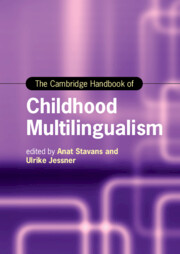Book contents
- The Cambridge Handbook of Childhood Multilingualism
- Cambridge Handbooks in Language and Linguistics
- The Cambridge Handbook of Childhood Multilingualism
- Copyright page
- Contents
- Figures
- Tables
- About the Editors
- Contributors
- Acknowledgments
- Multilingualism Is Not Bilingualism +1: An Introduction
- Part One Becoming and Being a Multilingual Child
- Part Two Cognition and Faculties in Multilinguals
- 5 Language and Thought in Multilingual Children
- 6 Multilingual Exposure and Children’s Effective Communication
- 7 Metalinguistic Awareness and Early Multilingual Learning
- 8 Code-Switching among Bilingual and Trilingual Children
- 9 Children’s Perception of Their Multilingualism
- 10 Multilingualism and Language Play
- Part Three Family Language Policy
- Part Four Language(s) and Literacy of Multilingual Children through Schooling
- Part Five Socialization in Childhood Multilingualism
- Part Six Multilingual Children’s Landscape
- Subject Index
- Country Index
- Language Index
- References
8 - Code-Switching among Bilingual and Trilingual Children
from Part Two - Cognition and Faculties in Multilinguals
Published online by Cambridge University Press: 18 August 2022
- The Cambridge Handbook of Childhood Multilingualism
- Cambridge Handbooks in Language and Linguistics
- The Cambridge Handbook of Childhood Multilingualism
- Copyright page
- Contents
- Figures
- Tables
- About the Editors
- Contributors
- Acknowledgments
- Multilingualism Is Not Bilingualism +1: An Introduction
- Part One Becoming and Being a Multilingual Child
- Part Two Cognition and Faculties in Multilinguals
- 5 Language and Thought in Multilingual Children
- 6 Multilingual Exposure and Children’s Effective Communication
- 7 Metalinguistic Awareness and Early Multilingual Learning
- 8 Code-Switching among Bilingual and Trilingual Children
- 9 Children’s Perception of Their Multilingualism
- 10 Multilingualism and Language Play
- Part Three Family Language Policy
- Part Four Language(s) and Literacy of Multilingual Children through Schooling
- Part Five Socialization in Childhood Multilingualism
- Part Six Multilingual Children’s Landscape
- Subject Index
- Country Index
- Language Index
- References
Summary
This chapter focuses on one of the most remarkable characteristics of bilinguals, namely their ability to effortlessly switch between two languages, and to combine grammar rules and words from each in one sentence. It offers a summary of what we know about the ways in which bilingual children code-switch and how this skill develops over time. Attention is paid to the variability in the patterns found in data sets from typologically different languages and social contexts. Analyses are also offered of the relationship between code-switching and language proficiency or language dominance. Differences or similarities with respect to switching among bilingual and trilingual children are discussed as well. Particular attention is given to the difficult issue of the (lack of) separation of grammars in code-switching, and to what extent code-switching patterns found among children differ from those of adults. Finally, there is a focus on the impact of code-switching on cognitive control. The chapter finishes with a summary of the key points and an outlook towards the future.
Keywords
- Type
- Chapter
- Information
- The Cambridge Handbook of Childhood Multilingualism , pp. 190 - 214Publisher: Cambridge University PressPrint publication year: 2022
References
- 1
- Cited by



